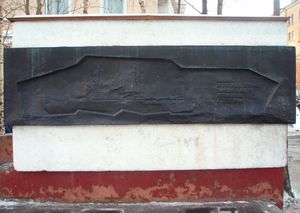Lenin (nuclear icebreaker)
| 300px The Lenin icebreaker docked at Murmansk | |
| Career | |
|---|---|
| Name: | Lenin (Ленин) |
| Launched: | 1957 |
| Completed: | 1959 |
| Out of service: | 1989 |
| Fate: | Preserved as a museum ship |
| General characteristics | |
| Displacement: | 16,000 tonnes |
| Length: | 134 m |
| Beam: | 27.6 m |
| Height: | 16.1 m |
| Draught: | 10.5 |
| Propulsion: | Nuclear:three 90 megawatt OK-150 reactors, later, two 171 megawatt OK-900 reactors, 4 turbine generators, three electrically driven propellers |
| Speed: | 18 knots (33 km/h) |
| Crew: | 243 |
| Notes: | Helicopters: 1 landing pad, aft |
NS Lenin is a Soviet icebreaker launched in 1957, and is both the world's first nuclear powered surface ship and the first nuclear powered civilian vessel. Lenin was put into operation in 1959 and officially decommissioned in 1989.
Propulsion
In the later configuration (two nuclear reactors), the reactors provided steam for four Kirov turbines. These were connected to generators, which powered three sets of electric motors to drive the ship's three propellers.
Nuclear accidents
When launched in 1957, Lenin was powered by three OK-150 reactors.
In February 1965, there was a loss of coolant accident. After being shut down for refueling, the coolant was removed from the number two reactor before the spent fuel had been removed. As a result, some of the fuel elements melted or deformed inside the reactor. This was discovered when the spent elements were being unloaded for storage and disposal. 124 fuel assemblies (about 60% of the total) were stuck in the reactor core. It was decided to remove the fuel, control grid, and control rods as a unit for disposal; they were placed in a special cask, solidified, stored for two years, and dumped in Tsivolki Bay (near the Novaya Zemlya archipelago) in 1967.

The second accident was a cooling system leak which occurred in 1967, shortly after refueling. Finding the leak required breaking through the concrete and metal biological shield with sledgehammers. Once the leak was found, it became apparent that the sledgehammer damage could not be repaired; subsequently, all three reactors were removed, and replaced by two OK-900 reactors. This was completed in the Spring of 1970.
Details of these accidents were not widely available until after the fall of the Soviet Union.
Retirement
Lenin was decommissioned in 1989, because her hull had worn thin from ice friction. She was laid up at Atomflot, a base for nuclear icebreakers in Murmansk, and according to Pravda.ru, repair and conversion into a museum ship was completed in 2005.
External links
- NKS Evaluation of Russian Marine Nuclear Reactors
- Bellona Foundation Article on Icebreaker Lenin
- Barbara Jancar-Webster (July 2001). "Red Atom: Russia's Nuclear Power Program from Stalin to Today by Paul R. Josephson (review)". Russian Review 60 (3): 452. http://links.jstor.org/sici?sici=0036-0341(200107)60%3A3%3C452%3ARARNPP%3E2.0.CO%3B2-4. Retrieved 2007-11-25. Critical article on Lenin Icebreaker
cs:Lenin (ledoborec) de:Lenin (Schiff) es:Rompehielos Lenin fr:Lénine (brise-glace) ko:레닌 쇄빙선 it:Lenin (rompighiaccio atomico) lt:Leninas (ledlaužis) nl:Lenin (atoomijsbreker) ja:レーニン (原子力砕氷艦) pl:NS Lenin ro:Spărgătorul de gheață V. I. Lenin ru:Ленин (атомный ледокол) fi:Lenin (jäänmurtaja) uk:Ленін (криголам)
